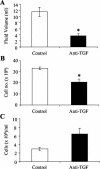Effect of neutralizing transforming growth factor beta1 on the immune response against Mycobacterium tuberculosis in guinea pigs
- PMID: 14977939
- PMCID: PMC356004
- DOI: 10.1128/IAI.72.3.1358-1363.2004
Effect of neutralizing transforming growth factor beta1 on the immune response against Mycobacterium tuberculosis in guinea pigs
Abstract
Transforming growth factor beta (TGF-beta) is a cytokine which has been shown to suppress the antimycobacterial immune responses of humans and experimental animals. In this study, the contributions of TGF-beta to cytokine production in vivo were investigated by using the established guinea pig model of tuberculous pleurisy. Mycobacterium bovis BCG-vaccinated guinea pigs were injected intrapleurally with heat-killed virulent Mycobacterium tuberculosis. Eight days following induction of an antigen-specific pleural effusion, guinea pigs were injected intrapleurally with anti-TGF-beta1 or isotype control antibody. The following day, pleural exudates were removed, and the fluid volume and characteristics of the infiltrating cells were determined. Pleural fluid was analyzed for total interferon (IFN) and tumor necrosis factor (TNF) protein levels by using appropriate bioassays. RNA from pleural effusion cells was examined to determine TGF-beta1, TNF-alpha, IFN-gamma, and interleukin-8 mRNA levels by using real-time PCR. Proliferative responses of pleural effusion lymphocytes were examined in response to concanavalin A and purified protein derivative (PPD) in vitro. Treatment with anti-TGF-beta1 resulted in decreased pleural fluid volume and decreased cell numbers in the pleural space along with an increased percentage of lymphocytes and a decreased percentage of neutrophils. The bioactive TNF protein levels in pleural fluid were increased in guinea pigs treated with anti-TGF-beta1, while the bioactive IFN protein concentrations were not altered. Expression of TGF-beta1 and TNF-alpha mRNA was significantly increased following TGF-beta1 neutralization. Finally, PPD-induced proliferative responses of pleural cells from anti-TGF-beta1-treated animals were significantly enhanced. Thus, TGF-beta1 may be involved in the resolution of this local, mycobacterial antigen-specific inflammatory response.
Figures





References
-
- Adams, D. H., M. Hathaway, J. Shaw, D. Burnett, E. Elias, and A. J. Strain. 1991. Transforming growth factor-β induces human T lymphocyte migration in vitro. J. Immunol. 147:609-612. - PubMed
-
- Allen, J. C., and M. A. Apicella. 1968. Experimental pleural effusion as a manifestation of delayed hypersensitivity to tuberculin PPD. J. Immunol. 101:481-487. - PubMed
-
- Bloom, B. R., and C. J. Murray. 1992. Tuberculosis: commentary on a reemergent killer. Science 257:1055-1064. - PubMed
-
- Brandes, M. E., U. E. Mai, K. Ohura, and S. M. Wahl. 1991. Type I transforming growth factor-β receptors on neutrophils mediate chemotaxis to transforming growth factor-β. J. Immunol. 147:1600-1606. - PubMed
Publication types
MeSH terms
Substances
Grants and funding
LinkOut - more resources
Full Text Sources
Miscellaneous

